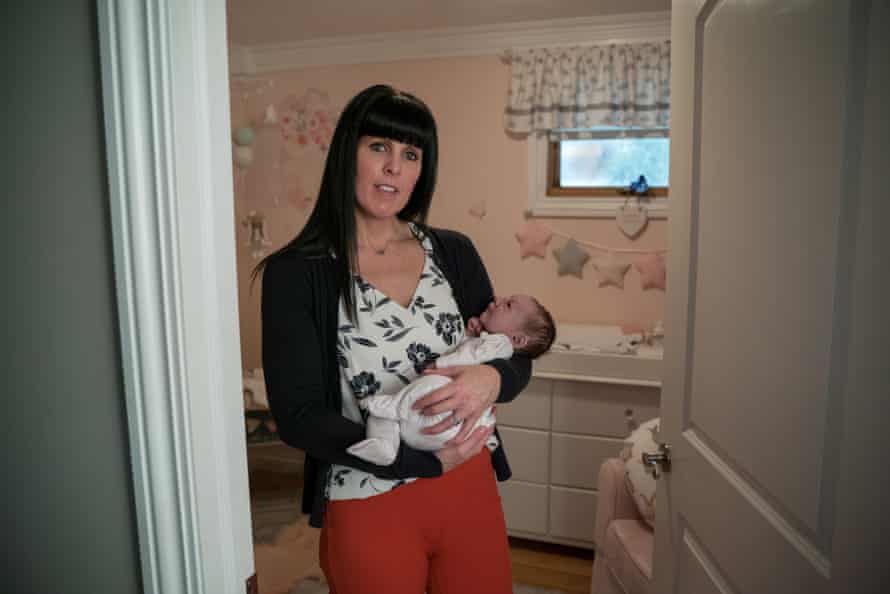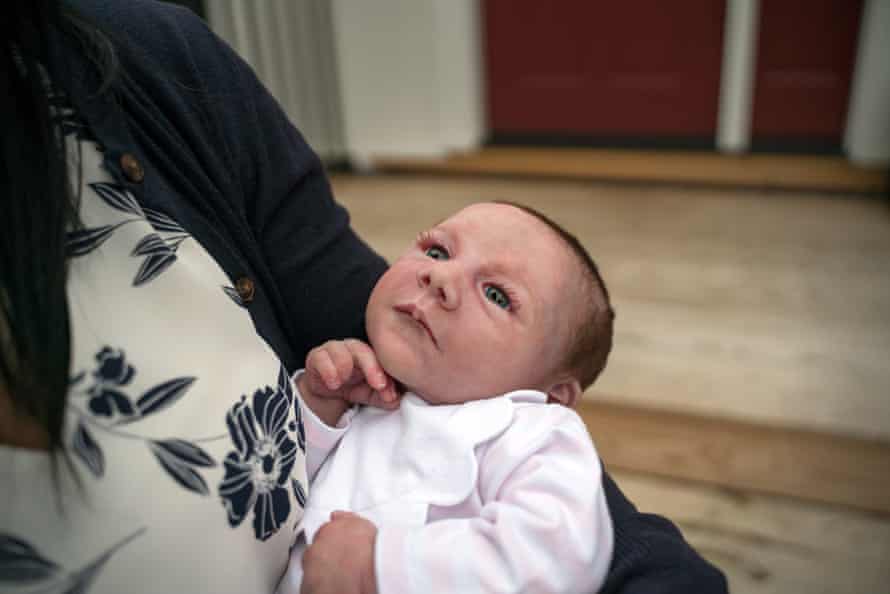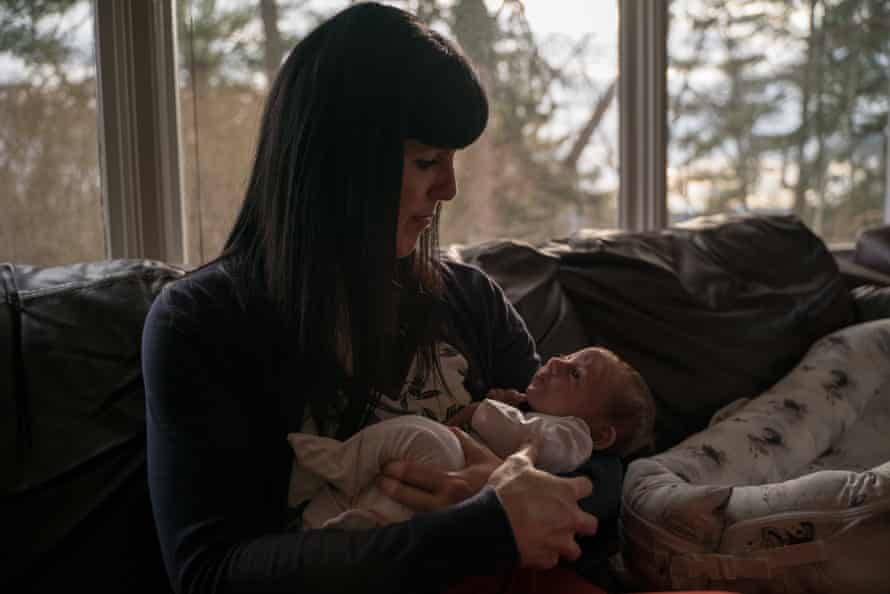How Do They Create Those Real Life Like Baby Dolls
I 'thou not sure what I expected a collector of hyper-realistic baby dolls to look like, but Kellie Eldred isn't it. On the frigid midwinter morn that I get in at her Ithaca, New York, dwelling, she greets me brightly in leggings and a cropped sweatshirt branded with the logo of a local Pilates studio. Her ink-blackness hair is pulled into a pert bun backside the most perfectly directly bangs I've ever seen. She simply finished working out, she tells me, as she leads me by her husband and a trio of friendly spaniels into a spotless kitchen. A squeaky toy appears at my anxiety; its four-legged owner barks for a reaction.
"Please," Eldred scolds the spaniel. To me, apologetically, she says: "She's just a little crazy."
"A trivial crazy" is the same way Eldred describes the vast network of doll buyers, sellers, creators and collectors she belongs to. From Sydney to Manchester, Tokyo to San Jose, its members spend upwards of $twenty,000 for one doll to add to their nurseries. Some of these collectors, like Eldred, have children of their own; many don't. Virtually are women. They meet in web forums and on Facebook, through YouTube channels and, of course, in the niche online marketplaces of Etsy and eBay.

It was on eBay, style back in 1999, that Eldred plant the doll that would change her life. Stripped of its mill-made features, this doll had been remodeled by an creative person – or, in the parlance of collectors, reborn – to improve resemble an bodily baby. Its body had been weighted with flour; Crayola box approximations of flesh tones were painted over in the bruised pulp palate of living human skin. In the shape of its optics, the doll bore a hit resemblance to Eldred'due south daughter Lexi as a baby.
"I'd never seen or heard of anything like information technology," she recalls. Though she agonized over its $100 price tag, she couldn't get the doll out of her head. While she's bought and sold dozens of other reborns since, she withal has her get-go.
In the more than ii decades since Eldred discovered these dolls, the rise of social media has expanded the number of worldwide collectors past an order of magnitude. Today, more than than 30,000 people subscribe to her YouTube aqueduct, where videos of her cuddling, changing and talking well-nigh dolls have amassed more than 14,450,000 views.
The proliferation of these lifelike dolls has led to innovations in the dolls' creation. Many of the latest dolls are custom-shaped from proprietary silicone blends and poured into molds that, in some instances, have been sculpted in the likeness of real newborns. The current star of Eldred'southward YouTube channel, a reborn named Monroe, was fabricated past a husband and wife squad of dollmakers whose unique silicone feels remarkably like skin to the touch.
"See how, if you lot press down on her arm, it takes a second for the skin to settle?" asks Eldred. I press, gently, to experience the skin yield beneath my fingertips. Squeez y, I call back. Like a retentiveness foam stress ball. Like a fatty baby'southward face.
Monroe is one of two dolls currently on display in the powder pink plant nursery where Eldred shoots her videos (she now has some misgivings about the color choice; "It doesn't always movie too well," she admits). There's a rocking chair and a crib, a changing table and a dresser. Scallop-collared ensembles by the French children'southward clothier Jacadi hang on tiny hangers. When I timidly ask about a infant canteen –white with what appears to be formula – perched aslope a tube of diaper ointment and talc, I'm assured that they're all just props. "There are collectors that beloved to office-play," she says. "I'm not that collector."
Deeply entrenched as she is in the online spaces, this is a hobby she keeps mostly to herself offline. She doesn't accept the dolls out in public, similar some collectors do. And, though she says her 2 adult daughters aren't fussed by her collecting – she's been into the hobby for almost of their lives – her hubby will occasionally permit slip a derisive remark during disagreements.
"Because of the hobby, and the misunderstanding, not really getting why nosotros love the hobby so much, I think it's hard for family members at times and information technology becomes an easy target," says Eldred in a 2019 video. Coping with outside judgment is a recurring topic on her YouTube channel, and one that'southward echoed by other doll creators and collectors online.

By and large, however, Eldred thinks that finger-pointing from outsiders may have waned in recent years. If nothing else, the customs's increased exposure on social media has made more people familiar with it. But Eldred tin't imagine a future in which her hobby is accustomed past the mainstream.
"Trying to explicate to a non-doll collector this emotional attachment to an inanimate object, people don't get it," she says in i of her YouTube videos. Its title: "Why Our Hobby Isn't Mainstream".
What are we to brand of grown women playing mommy with these dolls?
It's a question that Emilie St Hilaire, a humanities PhD student at Concordia Academy in Montreal, has spent the last iii years looking into. Her inquiry concerns the "queer and uncanny" aspects of reborns as a subcultural miracle. She'southward especially interested in the questions the hobby raises around non-reproductive mothering, adult modes of play and, concurrently, relationships with non-human surrogates. This means she often bumps upwards against the widely held assumption that reborn collectors are substituting dolls for children. It's a central misunderstanding of the nature of the hobby that belies deep-seated beliefs about a woman's role in social club.
"If you really try to unpack why a childless woman, particularly i who has something that looks similar a false baby, is threatening, then we start to become to what we run across as the function of women: a successful woman is a successful female parent," she says.
St Hilaire points out that, of the dozens of reborn collectors that she'due south surveyed worldwide, none think of their dolls equally "real" babies. (And, opposite to what many assume about collectors, she estimates that one-half of them already have children of their own.) Instead, St Hilaire has observed that the dolls tend to satisfy an imaginative crawling in collectors, whether they're making reborns from kits and online tutorials or merely choosing how to dress them. In her view, the dolls aren't child substitutes then much as companionate props in something similar a large-calibration roleplaying game.
"It doesn't make me want to have babies, at all," says Stephanie Ortiz, a maker and collector in her mid-30s. She and her wife Jackie ship the reborns they create in their Fresno, California, kitchen – where doll artillery, legs and heads of all hues hang on the walls like surrealist cabinetry – to buyers in the US, the UK, Australia, Deutschland, Canada and New Zealand. The YouTube channels where they show off their wares have about 400,000 subscribers altogether.
With her forthcoming manner and faux-militarist, Ortiz describes herself equally a lifelong tomboy. Merely for as long as she tin can remember, she's had a fascination with dolls. "I remember when I was a kid, I just wanted the near realistic baby [doll] I could take," she recalls. "Even as I was beating upward my cousins who were boys." To her, the dolls are about indulging her inner child and having fun; kids are a responsibleness. Every bit she wryly points out, a doll "doesn't plow into a teenager who wants an iPhone 11".
St Hilaire has establish that some collectors get a kick from bringing their dolls into public spaces and watching strangers mistake them for real babies. "It'southward like having a hush-hush," she says.
Recent pop cultural depictions tell a different story. An episode of the HBO series High Maintenance chronicles a adult female'due south descent into quasi-maternal delusion afterward ownership a silicone reborn she names "Babe Nico" and whose intendance and companionship become increasingly central to her life (to the chagrin of her baffled, all the same supportive, husband). She changes the doll'southward diapers, talks to it, takes it out. When the woman and her husband forget Baby Nico's stroller outside a hardware store, its dollness gets a heartbreaking and very public reveal – and becomes a proxy for the woman'due south unspoken loss and regret.
The new Apple Goggle box+ series Servant serves upwards a much less oblique indictment of reborn collectors' psychological states. In it, a couple have in a doll they name Jericho and treat equally a man baby, replete with a mysterious live-in nanny. Turns out – spoiler alarm – that the couple is mourning the recent death of their bodily babe (also named Jericho), and the doll is the bereft mother's only baby-sit against a grief-induced state of catatonia.
Though the fake baby trope is wildly misleading, it's true that reborn collectors don't run into their reborns as just toys. About, says St Hilaire, echo Eldred'due south emotional zipper to their dolls. St Hilaire describes this dynamic as "a kind of synthetic relationship".
"The feeling that you get from that," she says, "isn't so unlike from a real relationship"– that is, ane with a man analogue. Across social media, collectors speak openly of the special bond one tin develop with sure reborns, too equally the grieving period that sometimes follows once a doll is allow go (as with many collecting hobbies, reborns are commonly bought so sold or swapped out, changing hands within the community). In reborn relationships, St Hilaire sees promising implications for the hereafter of artificial intelligence and forms of non-human or humanoid companionship.
And so, in that location's the biological response that's triggered when handling a realistically proportioned, lifelike baby doll. Studies propose that doll therapy can reinforce feelings of zipper and emotional wellbeing in some patients with dementia. Many reborn collectors similarly point to the therapeutic benefits of their dolls for managing mental wellness conditions like anxiety and depression.
"There'south condolement in cuddling and physically property something that feels like a baby, fifty-fifty though it's not a baby," says St Hilaire. "It can release some of the same endorphins."
For Lucenda Plancarte, who is a friend of Ortiz and a reborn collector in her early 30s, the hobby'south therapeutic benefits are twofold.
"I take polycystic ovarian syndrome and stage iv endometriosis," she explains from her domicile in Compton, California. "And I've been proven infertile. I've already had multiple treatments, surgeries, seen unlike doctors. [Having children is] just not in my cards."

Stripped of her plans for biological motherhood, Plancarte fell into a deep low. She couldn't walk past the babe departments of her local Target and Walmart without being reminded of her unlucky draw. Simply, equally fate would take it, a solution emerged in 2012. And in an unexpected place: An episode of the TLC reality series My Strange Habit. The show had featured a reborn collector; Plancarte says she was "intrigued". Information technology was her hubby's idea that she buy one for herself, despite the $120 price tag.
"Then she arrived, and it was the most magical feel ever," says Plancarte. "I was in honey. It was astonishing. I was like, how in the globe have I never owned a reborn before? And information technology gave me a sense of purpose."
Plancarte loves being able to shop for her dolls in the same baby departments that were once a reminder of the things she was missing out on. Caring for them, she says, is a "coping mechanism".
Plancarte knows she's risking confrontation when she takes her dolls out in public. "Information technology comes with the territory," she says. When people ask questions, she answers: the dolls are objects of fine art, and they make her feel skillful. They're not replacements for children.
"Right now, fostering and adoption – it's non the right fourth dimension for me," she says. "And when it is, then I'll pursue that path. But right now, my path is collecting reborns, minding my own business, and sharing it with the earth on Instagram and YouTube."
-
This article was amended on 26 Feb 2020 to correct the proper name of Stephanie Ortiz'southward wife.
williamsthemannind.blogspot.com
Source: https://www.theguardian.com/lifeandstyle/2020/feb/26/reborn-doll-baby-lifelike-collecting-women
0 Response to "How Do They Create Those Real Life Like Baby Dolls"
Post a Comment